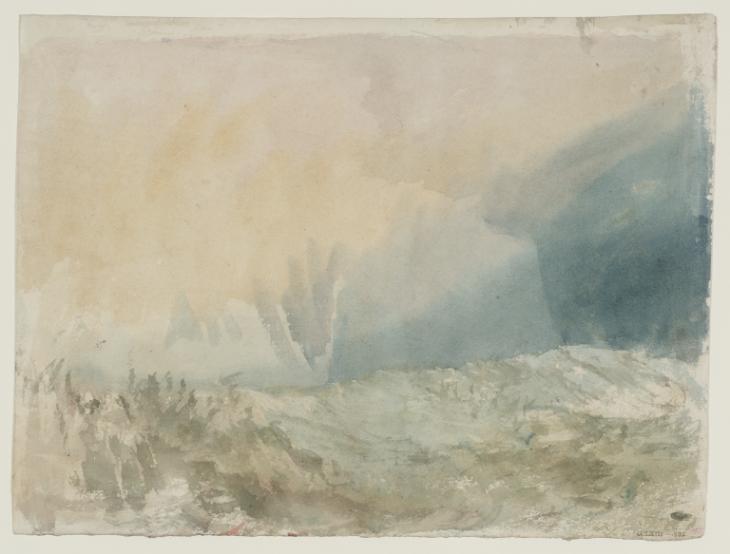Joseph Mallord William Turner The Bass Rock c.1824
Joseph Mallord William Turner,
The Bass Rock
c.1824
Joseph Mallord William Turner 1775–1851
The Bass Rock c.1824
D25327
Turner Bequest CCLXIII 205
Turner Bequest CCLXIII 205
Watercolour on white wove paper, 200 x 264 mm
Blind-stamped with Turner Bequest monogram towards bottom centre
Stamped in black ‘CCLXIII – 205’ bottom right
Blind-stamped with Turner Bequest monogram towards bottom centre
Stamped in black ‘CCLXIII – 205’ bottom right
Accepted by the nation as part of the Turner Bequest 1856
Exhibition history
1991
Turner: The Fourth Decade: Watercolours 1820–1830, Tate Gallery, London, January–May 1991 (5, as ‘Bass Rock: preparatory study’, c.1822–3, reproduced).
1997
Turner’s Watercolour Explorations 1810–1842, Tate Gallery, London, February–June 1997, Southampton City Art Gallery, June–September (37, as ‘Variant Study for “The Bass Rock”’, c.1824, reproduced).
1999
Turner and Sir Walter Scott: The Provincial Antiquities and Picturesque Scenery of Scotland, National Gallery of Scotland, Edinburgh, December 1999–March 2000 (38, as ‘Colour Study of The Bass Rock’, c.1824, reproduced in colour).
References
1820
A.J. Finberg, A Complete Inventory of the Drawings of the Turner Bequest, London 1909, vol.II, p.830, CCLXIII 205, as ‘Storm at sea’, c.1820–30.
1822
Ian Warrell, Turner: The Fourth Decade: Watercolours 1820–1830, exhibition catalogue, Tate Gallery, London 1991, p.28 no.5, as ‘Bass Rock: preparatory study’, c.1822–3, reproduced.
1824
Eric Shanes, Turner’s Watercolour Explorations 1810–1842, exhibition catalogue, Tate Gallery, London 1997, pp.19, 57 no.37, as ‘Variant Study for “The Bass Rock”’, c.1824, reproduced, 101 Appendix I ‘Scotland’.
1824
Katrina Thomson, Turner and Sir Walter Scott: The Provincial Antiquities and Picturesque Scenery of Scotland, exhibition catalogue, National Gallery of Scotland, Edinburgh 1999, pp.31, 94 no.38, as ‘Colour Study of The Bass Rock’, c.1824, pl.20 (colour).
The Bass Rock is an island formed of volcanic rock about a mile out in the Firth of Forth, some three miles from North Berwick in East Lothian, to the north-east of Edinburgh. In about 1824 Turner produced a watercolour design showing it isolated in rough seas (Lady Lever Art Gallery, Port Sunlight),1 which was engraved in 1826 for Walter Scott’s Provincial Antiquities of Scotland (see the Introduction to this section; Tate impressions: T04499–T04501, T06066). There are many drawings of the dramatic feature in the 1818 Bass Rock and Edinburgh sketchbook (Tate; Turner Bequest CLXV), but the design appears to derive in particular from two pencil studies from the south on a page in the 1822 King’s Visit to Edinburgh sketchbook (Tate D17646; Turner Bequest CC 79), with fortifications at the south-western end to the fore.
In recognising the subject of this ‘colour beginning’, Ian Warrell noted the ‘fluency’ of Turner’s application, ‘almost as an echo of the violent storm it depicts engulfing the rock’, while being ‘careful to anticipate the general colour structure of the final picture, and the rock stands out from the darkness of the surrounding elements’,2 although Eric Shanes has observed ‘much greyer weather’3 here than in the finished watercolour, with its central band of strong blues and a jagged bolt of lightning entering from the top right for good measure. He goes on: ‘Here Turner depicts the island catching the full force of an easterly wind, with clouds emerging from its leeward side and spume issuing from its summit. As in the final watercolour, the rock is viewed across a heavy swell’.4 Tate D35973 (Turner Bequest CCCLXIV 130) is a contemporary study exploring variations in the effects of colour, light and weather on the monolithic form.
A work showing the rock by moonlight last surfaced in 1905;5 another watercolour previously thought to show the rock in a storm6 is now considered a view of the Mew Stone, off the Devon coast near Plymouth, as set out in the Introduction to the Devonshire Rivers, No.3, and Wharfedale sketchbook (Tate; Turner Bequest CXXXIV) from which it originated, in the present author’s ‘West Country and Yorkshire 1814–17’ section of this catalogue.
Verso:
Blank; laid down.
Matthew Imms
July 2016
How to cite
Matthew Imms, ‘The Bass Rock c.1824 by Joseph Mallord William Turner’, catalogue entry, July 2016, in David Blayney Brown (ed.), J.M.W. Turner: Sketchbooks, Drawings and Watercolours, Tate Research Publication, February 2017, https://www

